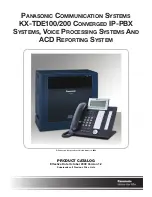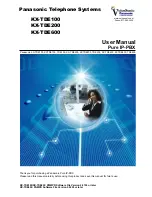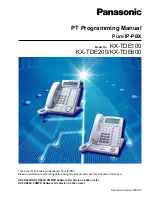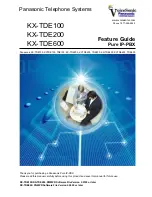
4.3.5.1 Network Direct Station Selection (NDSS)
Description
When PBXs are networked using ISDN or V-IPGW cards, it is possible to assign flexible buttons as Network
Direct Station Selection (NDSS) buttons. These buttons are used to monitor the status of extensions connected
to up to seven other PBXs in the network, and to make or transfer calls to those extensions with one touch,
like normal DSS buttons. This allows operator functions to be centralised even when there are offices in remote
locations.
NDSS buttons show the status of the monitored extension as follows:
Light pattern
Status
Off
The monitored extension is idle.
Red on
The monitored extension is busy or has set DND for trunk calls.
[Example Network]
PBX-1
Network
ID 1
PBX-2
Network
ID 2
2001 (busy)
2002 (idle)
4001 (idle)
PBX-3
Network
ID 0
PBX-4
Network
ID 3
Extn. 2001
Extn. 2002
Extn. 4001
1001 (busy)
Extn. 1001
Extn. 2002
Monitor extension
Monitor
extension
[Programming Procedure]
1.
Routing Table Assignment
TIE Line Routing and Modification tables must have been programmed in advance for all PBXs in the
network, to allow calls to be made and transferred between PBXs (
®
In the programming example that follows, the PBXs in the network use the Extension Number method, as
shown in the illustration above. However, the PBX Access Code method can also be used.
2.
Network PBX ID Assignment
Assign a Network PBX ID to each PBX in the network.
®
17.2 PBX Configuration—[9-2] Private Network—Network Data Transmission—
Transmission for Centralised Operator Feature—Network PBX ID
•
IDs 1-8: Can monitor extensions at other PBXs, and transmit monitor data about local extensions. Each
ID number can be assigned to one PBX within the network.
•
ID 0: Retransmits monitor data throughout the network. This ID number can be assigned to multiple
PBXs.
3.
QSIG Port Setting [Monitored PBX]
450
Feature Guide
4.3.5 QSIG Enhanced Features
Summary of Contents for KX-NS500
Page 14: ...14 Feature Guide Table of Contents...
Page 15: ...Section 1 For Your Safety Feature Guide 15...
Page 18: ...18 Feature Guide 1 1 1 For Your Safety...
Page 19: ...Section 2 Call Handling Features Feature Guide 19...
Page 57: ...632 Maximum Number of Agents Feature Guide 57 2 2 2 Incoming Call Distribution Group Features...
Page 107: ...User Manual References 1 2 1 Basic Calling Feature Guide 107 2 5 4 Trunk Call Features...
Page 193: ...User Manual References 1 4 2 Holding a Call Feature Guide 193 2 13 1 Call Hold...
Page 324: ...324 Feature Guide 2 30 2 Outgoing Message OGM...
Page 325: ...Section 3 Unified Messaging System Feature Guide 325...
Page 375: ...Section 4 Network Features Feature Guide 375...
Page 464: ...464 Feature Guide 4 3 6 Network ICD Group...
Page 465: ...Section 5 System Configuration and Administration Features Feature Guide 465...
Page 560: ...560 Feature Guide 5 6 7 PING Confirmation...
Page 561: ...Section 6 Appendix Feature Guide 561...
Page 578: ...578 Feature Guide 6 5 2 PFMPR Software File Version 004 2xxxx...
Page 579: ...Feature Guide 579 Notes...






































